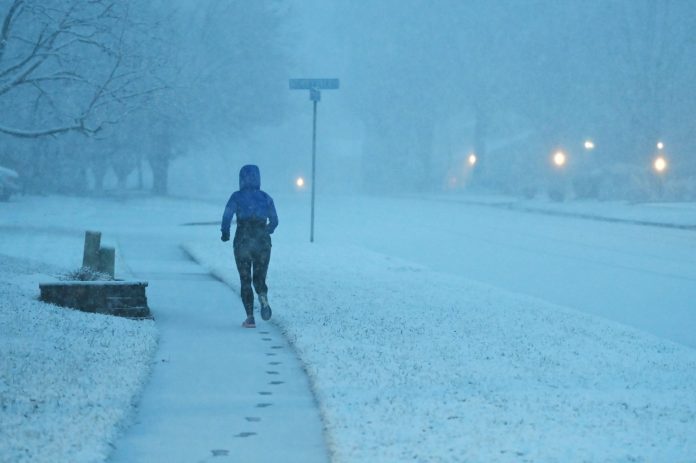

A rapidly-developing and dynamic storm system will bring a slew of meteorological chaos as it lashes the East Coast on Monday, yielding hefty snow totals for some along the Interstate 95 corridor and a dose of severe weather in the Carolinas.
Winter storm warnings stretch from Alabama to New Jersey, while areas in the Southeastern U.S. are likely to see strong winds and a chance of tornadoes. Half a million customers were without power at sunrise Monday due to strong winds.
Heavy snow was falling at midnight in Birmingham, Ala., with thundersnow reported northeast of Tuscaloosa in western parts of the state. Light rain broke out after midnight farther to the northeast in the nation’s capital, but that quickly switched to snow as cold air spilled south into the deepening, or intensifying, low pressure system.
Frigid air will arrive in the storm system’s wake Monday night into Tuesday, with overnight lows in the upper teens to lower 20s across the Mid-Atlantic. That will represent the coldest air to date this season. Frost and freeze warnings are in effect all the way down to the Gulf Coast in Texas and Louisiana.
Many are regarding the parent storm as a sneak-attack system, with the disturbance confounding weather models tasked with simulating its impacts. Only on Sunday did the scope and magnitude of the storm’s true impacts begin to come into focus; last week, it was hardly a blip to be concerned about.
A surface low over the southeastern U.S. will shift northeast over the Carolinas and intensify, energized by a mid-level shortwave, or dip in the jet stream filled with cold air, low pressure and spin, approaching from the west. The counterclockwise-rotating low will drag a tongue of warm, moist air northward on its eastern flank, with a cold air mass crashing south behind the storm.
Along and east of the Appalachians and in the Mid-Atlantic, that conveyor belt of mildness and moisture will wrap around the parent low and up over a wedge of cold, dense air hugging the ground. That process, known as “overrunning,” will result in a band of moderate to heavy snow accumulation.
To the east, a narrow quadrant of warmth is expected at the surface in the storm’s “warm sector” ahead of the cold front. A “string of pearls,” or band of rotating supercell thunderstorms, will arc northwest along the cold front, surging through the eastern Carolinas and Outer Banks.
Parts of the Mid-South in northern Alabama and the Cumberland Plateau of eastern Tennessee, as well as western North Carolina, picked up 2 to 4 inches in the lowlands and as much as 8 inches in the higher elevations. Huntsville saw snow barely 28 hours after being under a tornado watch, with at least one twister striking near the city’s airport. It hit a record high of 79 degrees on Saturday.
Data suggested a strip of mid-level frontogenesis, the formation of a cold front several thousand feet up in the atmosphere, draped from the Carolina Piedmont to southern parts of the Delmarva Peninsula. A conveyor belt of warm air forced up atop that encroaching lip of cold will result in enhanced upward motion and high snowfall rates.
Up to 8 inches of snow is expected in southwest Virginia when all is said and done, with a plowable snow of a half foot, give or take, between Richmond and Washington, D.C. The Delmarva Peninsula could be a jackpot zone as well. Baltimore and Philadelphia were predicted to be on the fringe of the heaviest snows, with winter weather advisories in effect and a couple inches possible. Temperatures Monday are slated to be up to 30 degrees cooler than on Sunday, when D.C.
Multiple flashes of thundersnow were reported in Carvers Gap, North Carolina, on the Tennessee border, around 5 a.m.
Snow will exit the Mid-Atlantic west to east during the afternoon, ending in Washington D.C. after lunch and Richmond by 2 or 3 p.m. By this evening, only the eastern tip of Long Island and perhaps Cape Cod, Martha’s Vineyard and Nantucket will see flakes flying.
A tornado watch was issued for northeastern parts of South Carolina and eastern North Carolina until 11 a.m. Eastern time, the National Weather Service Storm Prediction Center hoisting a level 2 out of 5 “slight risk” of severe weather. Damaging winds and a few tornadoes were expected as a squall line of rotating thunderstorms pushes east.
Most should move offshore of the Outer Banks by noontime or 1 p.m., with a break in the precipitation inside the storm’s “dry slot.” Temperatures will quickly cool, followed by a round of snow squalls and chilly winds gusting upward of 40 mph. At least 100,000 people were without power at 6 a.m. in western North Carolina as the winds began to kick up. Charleston International Airport gusted to 62 mph.
Chilly air swirling southeast behind the system could be the coldest in years in the Mid-Atlantic. Washington D.C. is expected to dip to 20 degrees Monday night, the coldest since January 31, 2019. Temperatures didn’t fall below 22 degrees in 2020, and 24 in 2021.
Raleigh, N.C., is predicted to make it to 23 degrees Monday night, and Baltimore will likely wind up around 19 degrees. Even far removed from any storminess, the storm’s broader circulation is playing a role in yanking down a frigid Canadian air mass. Even New Orleans and Houston are under freeze warnings.
Meanwhile, winter’s tempestuous caprice may not be over yet. Another messy mix might arrive with a storm on Friday.
(c) 2022, The Washington Post · Matthew Cappucci
{Matzav.com}





